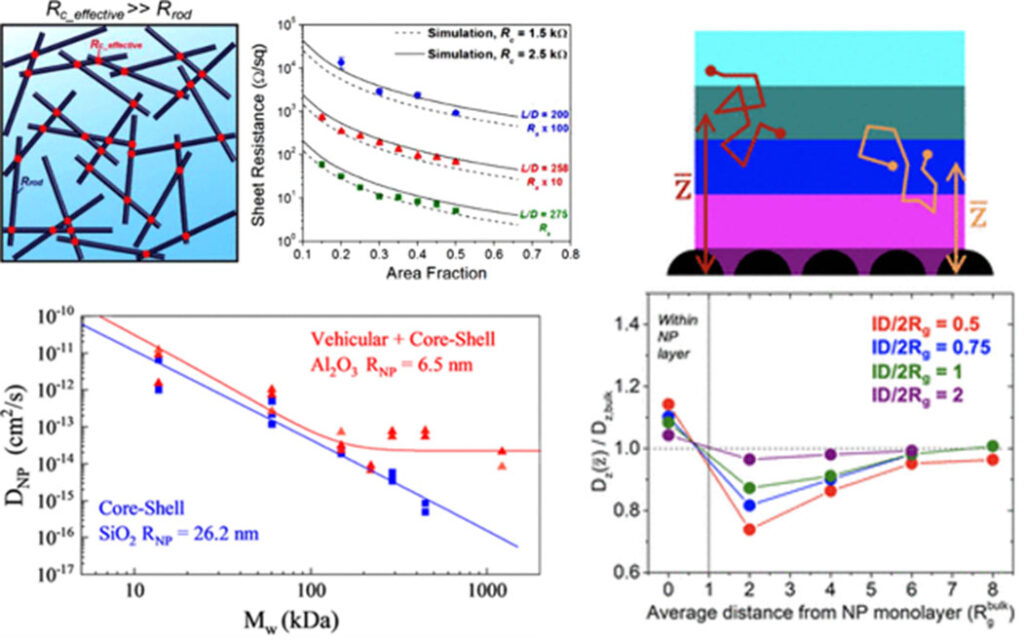
Overview: The Winey group has studied polymer nanocomposites since the earliest day of single-walled carbon nanotubes. By combining novel processing strategies to control the placement and orientation of the nanotubes, the group established the foundational understanding of how nanotubes impact nanocomposite properties. For example, a fine-scale SWNT network produced by her coagulation method is highly effective in providing a robust char that substantially improved flame retardance of the polymer. The Winey group also demonstrated that nanotube alignment in nanocomposites can improve mechanical properties, although alignment is detrimental to electrical conductivity due to fewer nanotube-nanotube contacts. Working with silver nanowires and using theory, simulations and experiments, her group established the importance of percolating nanowire networks in determining the electrical properties of nanocomposites in nominally 2D assemblies. By measuring the sheet resistance and understanding the network morphology, Winey’s group established a faster and more reliable method to measure the average contact resistance between metal nanowires, enabling the study of various surface chemistries.
Polymer nanocomposites and nanoporous substrates also provide new opportunities to study polymer diffusion in confined spaces wherein the distances between obstacles are on the order of the unperturbed radius of gyration. With the addition of carbon nanotubes, the polymer diffusion coefficient decreases non-monotonically with a minimum near the percolation threshold, a phenomenon described by anisotropic polymer diffusion near high aspect ratio fillers. In contrast, polymer diffusion in nanocomposites with spherical nanoparticles decreases monotonically with increasing nanoparticle concentration and, moreover, the normalized diffusion coefficient (DPNC/Do) versus the normalized effective interparticle distance (IDeff/2Rg) shows universal behavior. Notably, the normalized diffusion coefficient remains below one at IDeff/2Rg ~ 20, which the group was able to corroborate with molecular dynamics simulations. Relative to ion beam methods, the Winey group recently applied a more accessible method (ToF SIMS) for measuring polymer and nanoparticle diffusion in polymer melts to reveal the presence of core-shell and vehicular mechanisms of nanoparticle diffusion as distinguished by the polymer absorption time on the nanoparticles. The group also measured polymer melt diffusion in nanoporous substrates and detected faster polymer diffusion consistent with a reduction in polymer entanglement due to confinement.
- F. Du, J. E. Fischer, K. I. Winey*, J. Polym. Sci.: Polym. Phys., 41, 3333-3338, 2003. “Coagulation method for preparing single-walled carbon nanotube / poly(methyl methacrylate) composites and their modulus, electrical conductivity, and thermal stability.” https://doi.org/10.1002/polb.10701
- T. Kashiwagi*, F. Du, J. F. Douglas*, K. I. Winey, R. H. Harris, Jr., J. R. Shields, Nature Materials, 4, 928-933, 2005. “Nanoparticle networks reduce flammability of polymer nanocomposites.” https://doi.org/10.1038/nmat1502
- F. Du, J. E. Fischer, K. I. Winey*, Rapid Communication in Physical Review B, 72, 121404(R)-4, 2005. “Effect of nanotube alignment on percolation conductivity in carbon nanotube / polymer composites.” https://doi.org/10.1103/PhysRevB.72.121404
- S. I. White, B. A. DiDonna, M. Mu, T. C. Lubensky, K. I. Winey*, Physical Review B, 79, 024301, 2009. “Simulations and electrical conductivity of percolated networks of finite rods with various degrees of axial alignment.” https://doi.org/10.1103/PhysRevB.79.024301
- R. M. Mutiso, M. C. Sherrott, A. R. Rathmell, B. J. Wiley, K. I. Winey*, ACS Nano, 7, 7654-7663, 2013. “Integrating simulations and experiments to predict sheet resistance and optical transmittance in nanowire films for transparent conductors.” https://doi.org/10.1021/nn403324t
- M. Mu, N. Clarke, R. J. Composto, K. I. Winey*, Macromolecules, 42, 7091-7097, 2009. “Polymer diffusion exhibits a minimum with increasing single-walled carbon nanotube concentration.” https://doi.org/10.1021/ma901122s; 64 citations
- S. Gam, J. S. Meth, S. G. Zane, C. Chi, B. A. Wood, M. E. Seitz, K. I. Winey, N. Clarke, R. J. Composto*, Macromolecules, 44, 3494-3501, 2011. “Macromolecular diffusion in a crowded polymer nanocomposite.” https://doi.org/10.1021/ma102463q; 115 citations
- E. J. Bailey, K. I. Winey*, Macromolecules, 53, 8171-8180, 2020. “Polymer conformations and diffusion through a monolayers of confining nanoparticles.” https://doi.org/10.1021/acs.macromol.0c01524
- Kaitlin Wang, Karen I. Winey*, Macromolecules, 57, 6789-6795, 2024. “Vehicular and core-shell nanoparticle diffusion in attractive entangled polymer melts.” https://doi.org/10.1021/acs.macromol.4c00808
